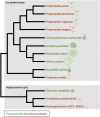A plastid without a genome: evidence from the nonphotosynthetic green algal genus Polytomella
- PMID: 24563281
- PMCID: PMC3982744
- DOI: 10.1104/pp.113.233718
A plastid without a genome: evidence from the nonphotosynthetic green algal genus Polytomella
Abstract
Polytomella spp. are free-living, nonphotosynthetic green algae closely related to the model organism Chlamydomonas reinhardtii. Although colorless, Polytomella spp. have a plastid, but it is still unknown whether they harbor a plastid genome. We took a next generation sequencing approach, along with transcriptome sequencing, to search for a plastid genome and an associated gene expression system in Polytomella spp. Illumina sequencing of total DNA from four Polytomella spp. did not produce any recognizable plastid-derived reads but did generate a large number of mitochondrial DNA sequences. Transcriptomic analysis of Polytomella parva uncovered hundreds of putative nuclear-encoded, plastid-targeted proteins, which support the presence of plastid-based metabolic functions, similar to those observed in the plastids of other nonphotosynthetic algae. Conspicuously absent, however, were any plastid-targeted proteins involved in the expression, replication, or repair of plastid DNA. Based on these findings and earlier findings, we argue that the Polytomella genus represents the first well-supported example, to our knowledge, of a primary plastid-bearing lineage without a plastid genome.
Figures



Similar articles
-
The Plastid Genome of Polytoma uvella Is the Largest Known among Colorless Algae and Plants and Reflects Contrasting Evolutionary Paths to Nonphotosynthetic Lifestyles.Plant Physiol. 2017 Feb;173(2):932-943. doi: 10.1104/pp.16.01628. Epub 2016 Dec 8. Plant Physiol. 2017. PMID: 27932420 Free PMC article.
-
The plastid proteome of the nonphotosynthetic chlorophycean alga Polytomella parva.Microbiol Res. 2021 Feb;243:126649. doi: 10.1016/j.micres.2020.126649. Epub 2020 Nov 28. Microbiol Res. 2021. PMID: 33285428
-
Next-generation sequencing data suggest that certain nonphotosynthetic green plants have lost their plastid genomes.New Phytol. 2014 Oct;204(1):7-11. doi: 10.1111/nph.12919. Epub 2014 Jun 24. New Phytol. 2014. PMID: 24962290 No abstract available.
-
When the lights go out: the evolutionary fate of free-living colorless green algae.New Phytol. 2015 May;206(3):972-82. doi: 10.1111/nph.13279. Epub 2015 Jan 26. New Phytol. 2015. PMID: 26042246 Free PMC article. Review.
-
Applications of next-generation sequencing to unravelling the evolutionary history of algae.Int J Syst Evol Microbiol. 2014 Feb;64(Pt 2):333-345. doi: 10.1099/ijs.0.054221-0. Int J Syst Evol Microbiol. 2014. PMID: 24505071 Review.
Cited by
-
Understanding the evolution of holoparasitic plants: the complete plastid genome of the holoparasite Cytinus hypocistis (Cytinaceae).Ann Bot. 2016 Oct 1;118(5):885-896. doi: 10.1093/aob/mcw135. Ann Bot. 2016. PMID: 27443299 Free PMC article.
-
Factors mediating plastid dependency and the origins of parasitism in apicomplexans and their close relatives.Proc Natl Acad Sci U S A. 2015 Aug 18;112(33):10200-7. doi: 10.1073/pnas.1423790112. Epub 2015 Feb 25. Proc Natl Acad Sci U S A. 2015. PMID: 25717057 Free PMC article.
-
In the beginning was the word: How terminology drives our understanding of endosymbiotic organelles.Microb Cell. 2019 Jan 21;6(2):134-141. doi: 10.15698/mic2019.02.669. Microb Cell. 2019. PMID: 30740458 Free PMC article.
-
Plastid-LCGbase: a collection of evolutionarily conserved plastid-associated gene pairs.Nucleic Acids Res. 2015 Jan;43(Database issue):D990-5. doi: 10.1093/nar/gku1070. Epub 2014 Nov 5. Nucleic Acids Res. 2015. PMID: 25378306 Free PMC article.
-
Cytonuclear integration and co-evolution.Nat Rev Genet. 2018 Oct;19(10):635-648. doi: 10.1038/s41576-018-0035-9. Nat Rev Genet. 2018. PMID: 30018367 Free PMC article. Review.
References
Publication types
MeSH terms
Substances
LinkOut - more resources
Full Text Sources
Other Literature Sources
Miscellaneous

